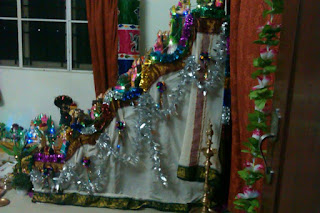The
Story of Diwali
Hello
there! This is Ranjani. I’m really excited to tell you about Diwali, which is
right around the corner and one of my favorite festivals ever!
Diwali
is known as the festival of lights in India. It is one of the biggest
festivals, celebrated all over India with firecrackers and fireworks from early
morning to late into the night. I will explain more about Diwali in the next
post, because Diwali is this Saturday, October 29, 2016! (Again, the dates
for Hindu festivals change every year. Last year, in 2015, Diwali was on
November 10th.)
There are many stories behind Diwali, depending on which state of India they are from and their religion. I'm going to introduce you to two of the ones I've heard. The first of these stories is one of the two great epics in
Hindu mythology: the Ramayana (RAA--MAA--ya-NAA). The second one is the story of Lord Krishna, who
goes on to be one of the main characters in the other great epic, the
Mahabharatha (ma-HAA--BHAA-ra-THA), and the God whose words comprise the entirety of the holy book,
the Bhagavad-Gita (BHA-GA-VAD--GEE-THAA).
Rama’s Return to Ayodhya
The Ramayana is the story of Lord Ram, or Rama (RAA-MAA), who
was sent on a 14-year exile from his kingdom Ayodhya (ah-YO-DHYA), on the day he was to be
crowned prince. Although Rama is the only one exiled, his wife Sita and brother Lakshmana (LACKSH-ma-na) (one of three brothers Rama has) follow him. During his exile, his wife, Sita (SEE-THAA), is kidnapped and taken to
Lanka by the demon Ravana (RAA-va-naa). Rama goes on a journey searching for her and makes
friends with monkeys, who constitute his army, and fight Ravana’s demon army.
They actually build a bridge of stones called the Rama Setu from the tip of
India to Sri Lanka – rocks that float all on their own and can support the
weight of anyone – which still exists today. Watch this video that tells you more about this amazing
bridge.
The day Rama returns back to Ayodhya after his 14-year
exile is said to be celebrated as Diwali.
One thing you need to understand about Indian epics is
that there are literally thousands of stories within that one big story,
and so much happens! Growing up, my parents had bought a DVD of the Ramayana
story in English for me and my brother to watch. Here’s a link to that. I encourage you to watch
it!
In the center, we have Sri Rama. To his right, we see his brother Lakshmana, and to his left, we see his wife Queen Sita. At Rama's feet, we see his devotee Hanuman.
Krishna vs Kamsa
Lord Krishna (Krish-NAA) is one of the most popular gods in
Hinduism. Again, there are lots of smaller stories about Krishna – perhaps more
than those about Rama – but the gist of it all is this: Krishna’s uncle Kamsa (COME-saa) heard a prophesy that the eigth son of his sister will kill him. Fearing for
his life, he locked up his sister and her husband in a stone prison. He killed
every child of theirs, but on the night of Krishna’s birth there were
supernatural occurrences that aided in his escape. His father carried the
newborn baby all the way to Vrindavan (VRIN-DAA-VUN) to the cowherder Nanda’s (NUN-DA) house and
exchanged Krishna for their newborn daughter while everyone was asleep. Thus
Krishna grew up in Vrindavan. Kamsa found out Krishna has escaped and was out
there somewhere and sent demon after demon to slay him. However, when the time
came, Krishna himself went to Mathura (MA-thu-raa), the city he was born in, and slayed
Kamsa.
Diwali is celebrated as the day Krishna slayed his
wicked uncle, Kamsa.
I’ve mentioned that Krishna’s story continues further
into the Mahabharatha epic. This article gives
you more detail on Krishna’s story, although there are still many smaller
stories that are not mentioned.
This is Lord Krishna, portrayed with his flute (Krishna ALWAYS has a flute he's playing) and a cow or two behind him denoting his childhood rearing cows in Vrindavan.
Another popular story behind Diwali is that of the slaying of a demon called Narakasura (na-ra-KAA-su-RAA); however, I am unfamiliar with that one.
And on that note, HAPPY DIWALI, EVERYONE!
























